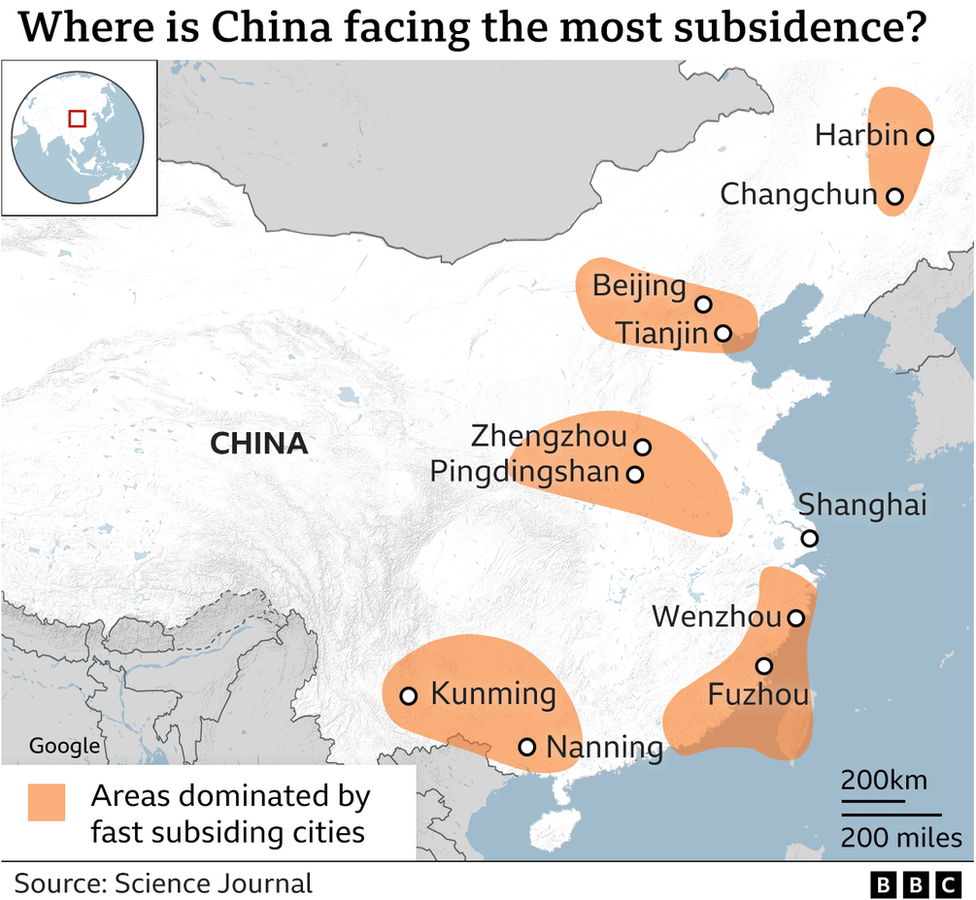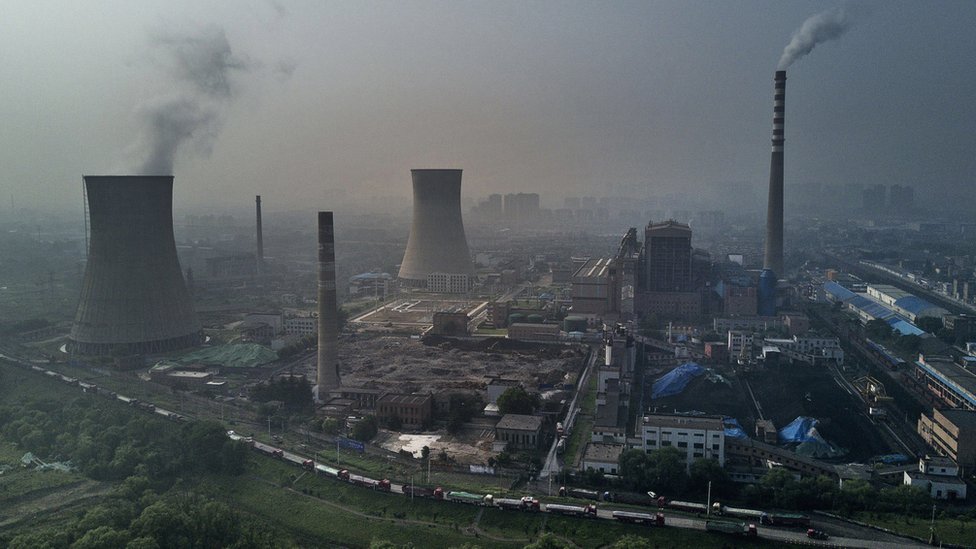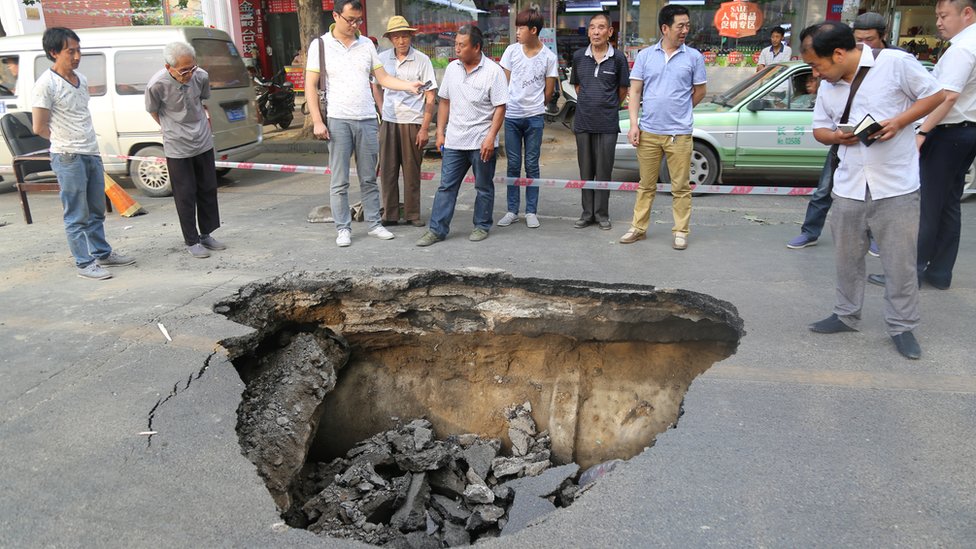A building subsides and collapses in Guangxi province
Nearly half of China’s major cities are sinking because of water extraction and the increasing weight of their rapid expansion, researchers say.
Some cities are subsiding rapidly, with one in six exceeding 10mm per year.
China’s rapid urbanisation in recent decades means far more water is now being drawn up to meet people’s needs, scientists say.
In coastal cities, this subsidence threatens millions of people with flooding as sea levels rise.
China has a long history of dealing with subsiding land, with both Shanghai and Tianjin showing evidence of sinking back in the 1920s. Shanghai has sunk more than 3m over the past century.
In more modern times, the country is seeing widespread evidence of subsidence in many of the cities that have expanded rapidly in recent decades.
To understand the scale of the problem, a team of researchers from several Chinese universities have examined 82 cities, including all with a population over 2 million.
They’ve used data from the Sentinel-1 satellites to measure vertical land motions across the country.
Looking across the period from 2015 to 2022, the team was able to work out that 45% of urban areas are subsiding by more than 3mm per year.
Around16% of urban land is going down faster than 10mm a year, which the scientists describe as a rapid descent.
Put another way, this means 67 million people are living in rapidly sinking areas.
The researchers say that the cities facing the worst problems are concentrated in the five regions highlighted on the map below.
The scale of decline is influenced by a number of factors, including geology and the weight of buildings. But a major element, according to the authors, is groundwater loss.
This essentially means the extraction of water underneath or near cities for use by the local population.
This has already been seen in several major urban areas around the world including Houston, Mexico City and Delhi.
China’s coal producing regions have long been linked to ground subsidence
In China, the research team were able to associate the extraction of water from over 1,600 monitoring wells with increasing levels of subsidence.
“I think the water extraction is, to my mind, probably the dominant reason,” said Prof Robert Nicholls, from the University of East Anglia, who was not involved in the research.
“In China there are lots of people living in areas that have been fairly recently sedimented, geologically speaking. So when you take out groundwater or you drain the soils, they tend to subside.”
Other factors that are influencing subsidence include urban transportation systems and mining for minerals and coal.
A large hole in the road in Zhengzhou, caused by subsidence
In the northern region of Pingdingshan, one of the largest coal areas in the country, land is subsiding at an extremely rapid 109mm per year.
The authors of the study say that a big threat going forward is the exposure of urban populations to flooding, from a combination of subsidence and sea level rise brought about by climate change.
In 2020, around 6% of China had a relative elevation below sea level. In 100 years time, this could rise to 26% of the country in a mid to high carbon emissions scenario.
The researchers say the land is sinking faster than the seas are rising, but together they would put hundreds of millions at risk of flooding.
However, research shows that there are effective strategies that can combat the slow decline.
Subsidence issues have afflicted other major urban centres in Asia, including Osaka and Tokyo in Japan in the past.
“Tokyo subsided around the port area, up to five metres in the 20th century,” said Prof Nicholls.
“But in the 1970s, they provided good piped water from other areas and they also had a law saying you will not use well water and essentially it stopped the subsidence.”
The study has been published in the journal Science.
News Related
-
Window opens for Zahid to ride off into the sunset – but at Anwar’s cost Sources within Umno have not ruled out strong speculation since last month about a so-called “exit plan” for Ahmad Zahid Hamidi, a move that could pave the way for his political retirement having survived more ...
See Details:
Window opens for Zahid to ride off into the sunset – but at Anwar's cost
-
Brianna Ghey died after she was found with fatal stab wounds in a park Two teenagers accused of murdering Brianna Ghey showed a “preoccupation” with “violence, torture and death”, a court has heard. The body of Brianna, 16, who was transgender, was discovered by dog walkers in a park in ...
See Details:
Murder-accused teens 'had preoccupation with torture'
-
ISLAMIC REVOLUTIONARY Guard Corps Commander-in-Cheif Major General Hossein Salami speaks at an anti-Israel protest in Tehran on Saturday. The IRGC trained Hezbollah to use human shields, say the writers. The conflict in Gaza has raised a deeply troubling issue: Reports suggest that Hamas is deliberately using civilians as shields, a ...
See Details:
A plea for Islamic voices against using human shields - opinion
-
Photo for illustration purposes only. – BERNAMA FILE PIX SHAH ALAM – The government needs to strengthen the Malaysia My Second Home (MM2H) programme, especially with the exemption of visas for Chinese and Indian citizens visiting the country starting Dec 1. Universiti Tun Abdul Razak economic expert Emeritus Professor Dr ...
See Details:
Strengthen MM2H programme, promote multiple entry visa
-
GEG element removed from anti-smoking Bill KUALA LUMPUR: The generational end-game (GEG) element has been removed from the revised Control of Smoking Products for Public Health 2023 Bill tabled for the first reading in the Dewan Rakyat on Tuesday (Nov 28). This is as the Health Ministry tries for the ...
See Details:
GEG element removed from anti-smoking Bill
-
-
-
KUALA LUMPUR (Nov 28): National carrier Malaysia Airlines Bhd has launched its year-end sale with ticket prices starting from RM79 to domestic destinations and from RM229 to international destinations, for travellers who book flights between Nov 28 and Dec 11 this year. In a statement, Malaysia Airlines said all-in one-way Economy Class ...
See Details:
Malaysia Airlines launches year-end sale
-
KUALA LUMPUR (Nov 28): National carrier Malaysia Airlines Bhd has launched its year-end sale with ticket prices starting from RM79 to domestic destinations and from RM229 to international destinations, for travellers who book flights between Nov 28 and Dec 11 this year. In a statement, Malaysia Airlines said all-in one-way Economy Class ...
See Details:
Dr M accuses govt of bribery over allocations
-
KUALA LUMPUR (Nov 28): National carrier Malaysia Airlines Bhd has launched its year-end sale with ticket prices starting from RM79 to domestic destinations and from RM229 to international destinations, for travellers who book flights between Nov 28 and Dec 11 this year. In a statement, Malaysia Airlines said all-in one-way Economy Class ...
See Details:
Malaysia to check if the Netherlands still keen to send flood experts
-
KUALA LUMPUR (Nov 28): National carrier Malaysia Airlines Bhd has launched its year-end sale with ticket prices starting from RM79 to domestic destinations and from RM229 to international destinations, for travellers who book flights between Nov 28 and Dec 11 this year. In a statement, Malaysia Airlines said all-in one-way Economy Class ...
See Details:
Appeals court to rule in Isa’s graft case on Jan 31
-
KUALA LUMPUR (Nov 28): National carrier Malaysia Airlines Bhd has launched its year-end sale with ticket prices starting from RM79 to domestic destinations and from RM229 to international destinations, for travellers who book flights between Nov 28 and Dec 11 this year. In a statement, Malaysia Airlines said all-in one-way Economy Class ...
See Details:
Elephants Trample On Axia With Family Of Three Inside
-
KUALA LUMPUR (Nov 28): National carrier Malaysia Airlines Bhd has launched its year-end sale with ticket prices starting from RM79 to domestic destinations and from RM229 to international destinations, for travellers who book flights between Nov 28 and Dec 11 this year. In a statement, Malaysia Airlines said all-in one-way Economy Class ...
See Details:
Sirul fitted with monitoring device
-
KUALA LUMPUR (Nov 28): National carrier Malaysia Airlines Bhd has launched its year-end sale with ticket prices starting from RM79 to domestic destinations and from RM229 to international destinations, for travellers who book flights between Nov 28 and Dec 11 this year. In a statement, Malaysia Airlines said all-in one-way Economy Class ...
See Details:
Nigerian airliner lands at wrong airport
OTHER NEWS
THOSE looking for fresh produce may find themselves spoilt for choice at the biggest wet market in Klang, but visitors to the place say the condition of the facilities and ...
Read more »
Olive Grove is the first-ever gated-and-guarded development in Bercham, Ipoh with 24-hour security. IPOH: YTL Land and Development Bhd announced that Phase 1 of Olive Grove is fully sold while ...
Read more »
Screenshots of a video showing a teenager pointing a knife at an elderly e-hailing driver. PETALING JAYA: Police have arrested a 13-year-old boy for holding an elderly e-hailing driver at ...
Read more »
Sprint Highway’s Semantan To KL Slip Road Fully Closed Until Dec 31 If you’re a regular user of the Sprint expressway, you’ll need to do some planning for your trips ...
Read more »
Genshin Impact Version 4.3 Leak Showcases Update to Domains New leaks reveals a quality-of-life update to Domains in Genshin Impact, making it easier for players to repeat and farm resources. ...
Read more »
CG Computers will host the Urban Republic (UR) Warehouse Clearance from 30 November to 3 December at the Atria Shopping Gallery in Petaling Jaya. During the event, visitor can get ...
Read more »
Photo for illustrative purposes only – 123RF KUALA LUMPUR – Hyperinflation has never happened in Malaysia and the government hopes it will never happen, according to the Economy Ministry. It ...
Read more »




